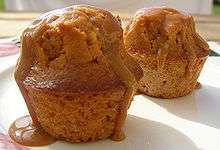Dulce de leche
Dulce de leche (Spanish: [ˈdulse ðe ˈletʃe/ˈdulθe ðe ˈletʃe]; Portuguese: doce de leite IPA: [ˈdosi dʒi ˈlejtʃi]) is a confection from Latin America prepared by slowly heating sweetened milk (most commonly cow milk) to create a substance that derives its flavor from the Maillard reaction, also changing color.[1] Dulce de leche is Spanish for "Sweet [made] of milk". dulce de leche is known as "manjar de leche" or just "manjar".[1]
 A jar of dulce de leche | |
| Alternative names | Manjar, manjar blanco, arequipe, doce de leite (Brazil) |
|---|---|
| Type | Confectionery |
| Region or state | Latin America |
| Main ingredients | Milk, sugar |
| Variations | Cajeta, arequipe |
Preparation and uses

The most basic recipe calls for slowly simmering milk and sugar, stirring almost constantly. Other ingredients such as vanilla may be added for flavor. Much of the water in the milk evaporates and the mix thickens; the resulting dulce de leche is usually about a sixth of the volume of the milk used. The transformation that occurs in preparation is caused by a combination of two common browning reactions called caramelization and the Maillard reaction.[2]
A homemade form of dulce de leche sometimes is made by boiling an unopened can of sweetened condensed milk for two to three hours (or 30 to 45 minutes in a pressure cooker), particularly by those living in countries where it cannot be bought ready-made. This results in a product that is much sweeter than the slow-boiled kind. It is dangerous to do this on a stove: if the pot is allowed to boil dry, the can will overheat and explode.[3]
Dulce de leche is used to flavor candies or other sweet foods, such as cakes, churros, cookies (see alfajor), waffles, crème caramel (known as flan in Spanish- and Portuguese-speaking regions), and ice creams; it is also a popular spread on crepes (panqueques) and toast, while the French confiture de lait is commonly served with fromage blanc.
See also
References
- "Origen mítico del dulce de leche" [The Mythical Origin of Dulce de Leche] (in Spanish). Clarín. 6 April 2003. Retrieved 8 June 2014.
- McGee, Harold (2004). On Food and Cooking: The Science and Lore of the Kitchen. New York: Scribner. p. 657. ISBN 0-684-80001-2. Retrieved August 8, 2012.
- Kijac, Maria Baez (2003). The South American Table: The Flavor and Soul of Authentic Home Cooking from Patagonia to Rio de Janeiro, with 450 Recipes. Boston, MA: Harvard Common Press. p. 391. ISBN 1-55832-249-3. Retrieved August 8, 2012.
| Wikimedia Commons has media related to Dulce de leche. |